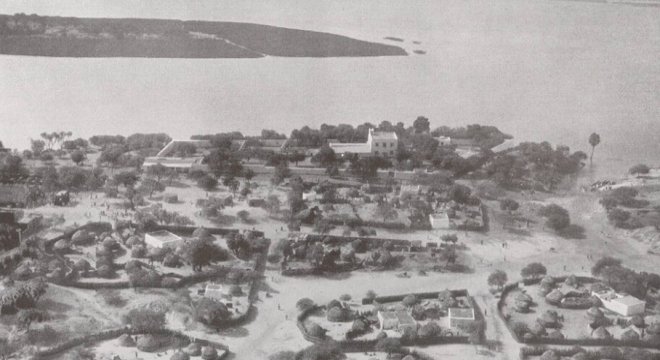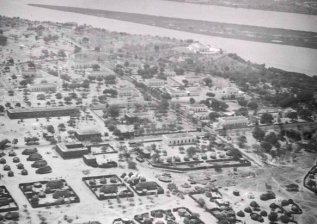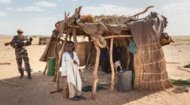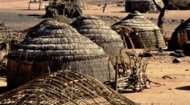|
Administrative buildings, government offices, and residences for European officials were constructed, often in a distinct grid-like pattern that characterised colonial urban planning. (The above photo shows Niamey in December 1930 with the large house in the centre being the French governor's residence.) Road networks were established connecting Niamey to other key colonial centres and facilitating the movement of goods and personnel. The development of port facilities along the Niger River was crucial, turning the city into a major collection and distribution point for agricultural produce, livestock, and other resources destined for export or internal trade. This economic activity attracted a diverse population, including colonial administrators, military personnel, traders, and local labourers, leading to a significant increase in the city's population and ethnic diversity.
By the time Niger gained independence in 1960, Niamey was a well-established urban centre with a foundational infrastructure, a diverse population, and a clear administrative function. The city's growth and layout remain a tangible legacy of the French colonial period, demonstrating how external forces can rapidly alter the trajectory of a nascent urban landscape, transforming from a modest administrative town into a sprawling metropolis that now draws people from every corner of the nation. Today with its population of 1.56m, Niamey, as the capital and largest city of the Republic of Niger, serves as the nation's administrative, economic, and cultural heart. Niamey’s economic profile is fundamentally administrative and service-oriented. As the seat of government, it is the largest employer of civil servants, and its economy is heavily influenced by government spending and the presence of foreign embassies and international non-governmental organisations. The formal sector includes banking, telecommunications, and a modest light industrial base focused on products like textiles, processed foods, and construction materials. However, the formal economy tells only part of the story. The true engine of daily commerce is the sprawling informal sector. This vibrant, unregulated economy employs the majority of Niamey’s residents and is visible everywhere, from the bustling labyrinth of the Grand Marché to the countless roadside stalls selling everything from fresh produce to mobile phone credits. Motorcycle taxis, known as "kabu-kabu," weave through traffic, providing essential transport and livelihoods for thousands. Artisans producing leather goods, pottery, and silver jewellery contribute to a rich craft economy. This informal sector demonstrates incredible resilience and ingenuity, though its participants often lack the job security and social protections of formal employment. |
Niamey Profile |
Niamey Profile |
Niamey Profile | Niamey Profile |
For information, videos and photos of the country of Niger Niger, check out our Niger profile pages.
More >
 |

|
The social profile of Niamey is a reflection of Niger's ethnic diversity. While the Zarma-Songhai people form the historical and demographic core of the city, Niamey is home to significant populations of Hausa, Tuareg, Fulani, Kanuri, and Gourmantché, among others. While French remains the official language of government and education, the lingua franca of the markets and neighbourhoods is a blend of local languages, most prominently Zarma and Hausa. Religion is a cornerstone of social life, with the vast majority of the population adhering to Sunni Islam. The daily rhythm of the city is punctuated by the five calls to prayer, and the Grand Mosque of Niamey, with its towering minaret, stands as a powerful symbol of this shared faith. This Islamic identity is often interwoven with traditional beliefs and customs, creating a unique cultural synthesis. Niamey is also a remarkably young city, reflecting Niger's national demographic of having one of the youngest populations in the world. This youthfulness infuses the city with a dynamic, if sometimes restless, energy, but it also places immense pressure on education and employment systems. Like many rapidly growing cities in Africa, Niamey faces a host of significant challenges. Decades of rapid, often unplanned, urbanisation have placed an immense strain on public infrastructure. Access to clean water, reliable electricity, and sanitation services remain a daily struggle for many residents, particularly in the ever-expanding peripheral neighbourhoods. The city's growth has also exacerbated environmental pressures, from waste management issues to the ever-present threat of desertification advancing from the north. Economic precarity is another pressing concern. High unemployment, especially among the youth, fuels competition for scarce resources and opportunities. The city's economic health is also intrinsically linked to the fortunes of the nation's rural, agricultural economy, which is highly vulnerable to the impacts of climate change, such as erratic rainfall and prolonged droughts. Furthermore, the broader security challenges affecting the Sahel region, while more acute in border areas, cast a shadow over the capital, leading to an increased security presence and a general sense of caution. Despite its challenges, daily life in Niamey is characterised by a vibrant and communal energy. The day often begins before dawn with the first call to prayer. As the sun rises, the streets come alive with the sounds of commerce and conversation. The markets, particularly the Grand Marché and the Petit Marché, are the city's pulsing heart where Niger’s diverse cultures converge. The Niger River is inevitabley the city's soul. It's a place of work for fishermen in their pirogues, a source of leisure for families strolling along its banks in the evening, and a vital ecological landmark. A walk across the Kennedy Bridge offers panoramic views of the water and the city skyline. One of Niamey's most unique attractions is the presence of a pod of hippos that can often be seen bathing in the river, a surprising encounter with wildlife in the heart of a capital city. Niamey's few attractions include the Musée National Boubou Hama. This unique open-air museum is one of the finest in Africa, with a number of exhibitions housed inside Hausa-style pavilions from where you can explore all about traditional dress, the homes and tools of Niger's diverse ethnic groups, the history of the Sahara, and the country's customs and traditions. There you can also see the remains of the 'Tenere Tree', once considered the most isolated tree on Earth as it was the only one for ninty-three miles and used as a landmark on the old caravan routes through the Sahara Desert in north-east Niger. We say 'remains' because this tree, so steeped in mythology and folklore that it was the only tree to be shown on a map at a scale of 1:4,000,000, was accidentally knocked down in 1973 by a truck driver. As you do. The complex also includes a zoo and a craft centre where visitors can watch artisans at work. Visitors to Niamey are also recommended to visit the Grand Mosque that was built in the 1970s and from where, after you've climbed its minaret's gruelling 171 steps, you can get amazing views of the city. A trip on the Niger in a pirogue is also available if you're keen to see the hippos mentioned above close up which actually isn't recommended. The hippos close up that is, given they are estimated to kill around 500 people every year in Africa, though this figure is uncertain due to a lack of reliable, centralised data on human-wildlife conflict in remote regions. They are considered the deadliest large land mammal on the continent due to their aggressive, territorial nature and powerful bites, often killing people who encroach on their territory or get too close to them in the water. Vistors to Niamey should be aware that levels of crime are high with frequent robberies and thefts. After you've watched the video to get further insights into Niamey, make a virtual landing at Diori Hamani International Airport above then explore Niamey using our interactive map, also linked to above. |

 While development was primarily driven by colonial administrative and economic imperatives - efficiency in governance, resource extraction, and military control - it also laid the groundwork for Niamey's future. Basic social services, such as schools and healthcare facilities, were introduced, albeit often limited in scope and primarily serving the colonial elite or specific local populations.
While development was primarily driven by colonial administrative and economic imperatives - efficiency in governance, resource extraction, and military control - it also laid the groundwork for Niamey's future. Basic social services, such as schools and healthcare facilities, were introduced, albeit often limited in scope and primarily serving the colonial elite or specific local populations.






